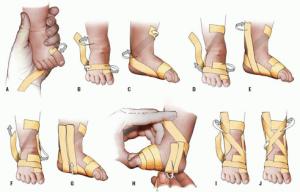Understanding Clubfoot: Causes and Diagnosis
Because a newborn’s bones, joints and tendons are very flexible, treatment for clubfoot usually begins in the first week after birth. The goals of treatment are to move the child’s foot into a corrected position with the bottom of the foot facing the ground. Treatment with casting allows for the best movement of the foot and best long-term results. Treatment is most effective if done in the first few months of age.
Treatment options include:
- Stretching, splinting and taping, called the French method
- Stretching and casting, called the Ponseti method.
The French Method for Treating Clubfoot at Home
The French method is a well-established approach for managing clubfoot, focusing on gradual correction through manipulation and specific bandaging techniques. This method emphasizes the importance of daily care and consistent adherence to treatment protocols, enabling parents and caregivers to participate actively in their child’s recovery process. The foundational principle of the French method is to gently realign the foot into its proper position while fostering joint flexibility.
To implement the French method at home, caregivers can begin by positioning the child comfortably and assessing the foot’s current alignment. A systematic approach involves the following steps: First, the caregiver should carefully manipulate the foot, applying gentle pressure to encourage realignment. For effective correction, this manipulation should be performed twice daily, incorporating stretching and rotation exercises. Following the manipulation, the foot must be bandaged using a specific technique that promotes stability while allowing for movement. The bandaging starts at the toes, moving towards the ankle, ensuring that the toes are properly aligned and not constricted.
Regular follow-ups with healthcare professionals are vital to monitor progress and make necessary adjustments. It is advisable for caregivers to document daily changes in the foot’s condition, noting any improvements or challenges encountered during treatment. This record not only assists in consultations with healthcare providers but also reinforces the caregiver’s involvement in the treatment process.
While the French method offers numerous advantages, such as fostering independence in caregivers and promoting active involvement in the treatment journey, it also presents challenges. Consistent application of the method may be demanding, requiring commitment and patience. Awareness of these factors can enhance the overall implementation of the French method at home, leading to successful outcomes for children with clubfoot.
The Ponseti Method: A Proven Approach to Clubfoot Treatment
The Ponseti method is a highly regarded approach for the treatment of clubfoot, especially noted for its effectiveness in achieving long-term positive outcomes for children. This method primarily relies on gentle manipulation, casting, and aftercare to correct the deformity in a safe and effective manner. Initially, the treatment begins with the careful stretching and positioning of the foot into a more natural alignment, which is then maintained through a series of plaster casts applied to the lower leg. These casts are typically changed every week for about 6 to 8 weeks, allowing the foot to gradually adjust closer to normal positioning.
For parents looking to implement the Ponseti method at home, it is essential to follow the prescribed casting schedule closely and ensure the integrity of the casts. After the casting phase, a minor surgical procedure known as tenotomy may be recommended to lengthen the Achilles tendon, which will allow greater flexibility and movement. Following the tenotomy, the child will need to wear a specialized orthotic bracing device to maintain the correction made during treatment. This phase is crucial as consistent use of the braces helps prevent relapses, promoting the stability of the foot’s alignment.
Post-treatment, regular follow-up appointments with a healthcare professional are vital. These visits allow for monitoring of the child’s progress and the early identification of any potential complications that may arise. Benefits of the Ponseti method include minimal invasiveness compared to traditional surgical methods, as well as a high success rate in preventing future foot deformities. Through diligent adherence to the treatment plan, including the incorporation of the Ponseti method’s principles into home care routines, families can significantly improve their child’s chances for a successful and fulfilling future.
Comparing the French and Ponseti Methods: Which is Right for Your Child?
When addressing the treatment of clubfoot, the French and Ponseti methods present two distinct avenues that parents can consider for their child’s care. Understanding the differences between these approaches is crucial for making an informed decision about management strategies. Both methods aim to correct the deformity effectively, yet they vary in technique and the level of parental involvement required.
The Ponseti method is often recognized for its structured use of serial casting. Initially, it involves manipulating the foot into the correct position, followed by the application of casts that are changed weekly for several weeks. This technique is typically followed by the use of a brace to maintain correction. The effectiveness of the Ponseti method is well-documented, with studies indicating high rates of success in achieving functional and aesthetic foot positions. However, the method necessitates consistent follow-up care, which may require parents to arrange appointments with health care professionals regularly.
Several factors may influence families when choosing between these methods. The severity of a child’s clubfoot, availability of resources, and the presence of healthcare providers familiar with each approach are crucial considerations. Additionally, personal preferences, comfort level with home-based treatment, and access to professional support can greatly affect the choice. Evaluating these aspects will empower parents, leading them to select the approach that best aligns with their specific circumstances and their child’s needs.


